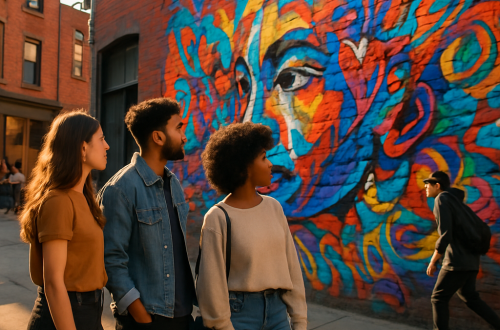The Evolution of Street Art as a Cultural Movement

From rebellious tags on subway cars to celebrated murals in urban galleries, street art has undergone a remarkable transformation over the past half-century. What began as a form of expression for marginalized youth has evolved into a global cultural phenomenon that challenges traditional notions of art, public space, and social commentary.
Street art represents one of the most significant artistic movements of our time – a democratic, accessible form of creative expression that breaks free from the confines of museums and galleries to engage directly with communities. Its evolution from criminalized graffiti to respected art form reflects broader shifts in how society values alternative voices and reconsiders the boundaries between high and low culture.
From Vandalism to Validation
The roots of contemporary street art can be traced back to the late 1960s and early 1970s in Philadelphia and New York City. Young people, particularly from marginalized communities, began writing their names or “tags” on walls and subway cars. Artists like TAKI 183, a Greek-American teenager from Washington Heights, gained notoriety when his tag appeared throughout the city, eventually leading to a profile in The New York Times in 1971.
This early period was characterized by simple signatures that evolved into increasingly elaborate styles. The competitive nature of tagging pushed artists to develop distinctive lettering and characters. What began as a way for young people to gain recognition in their neighborhoods transformed into an underground art movement with its own aesthetic principles and cultural codes.
The 1980s marked a pivotal moment when graffiti began to intersect with the mainstream art world. Artists like Jean-Michel Basquiat and Keith Haring, who had roots in street art, gained recognition in traditional galleries. Their success created a bridge between street culture and fine art institutions, though this transition was neither smooth nor universally welcomed.
“I was just a kid from the Bronx with a spray can and something to say,” recalls veteran graffiti artist Carlos Rodriguez. “We weren’t thinking about galleries or museums. We were making art for ourselves and our communities. Nobody asked permission – that was the point.”
During this period, street art remained largely criminalized. New York City’s aggressive anti-graffiti campaigns, including the infamous “war on graffiti” launched by Mayor Ed Koch, pushed many artists underground or forced them to abandon their work altogether. The introduction of harsh penalties and new cleaning methods threatened to eradicate the movement.
Yet despite these challenges, street art continued to evolve. By the 1990s, artists began experimenting with new techniques beyond traditional spray paint, including stencils, posters, stickers, and installations. This diversification expanded the visual vocabulary of street art and attracted new practitioners from diverse backgrounds.
The rise of artists like Shepard Fairey, with his “Obey Giant” campaign, and Banksy, with his satirical stencil work, demonstrated how street art could communicate complex political and social messages while captivating public imagination. These artists showed that street art could be both accessible and intellectually engaging, challenging viewers to reconsider their surroundings and social assumptions.
Global Movement and Digital Amplification
The turn of the millennium saw street art transform into a truly global phenomenon. Cities like Berlin, São Paulo, Melbourne, and London developed their own distinctive street art scenes, each reflecting local cultural influences while participating in a global conversation.
The internet and social media played a crucial role in this expansion. Digital platforms allowed street artists to document their ephemeral work and share it with global audiences. A mural painted in Buenos Aires could inspire artists in Tokyo within hours. This connectivity accelerated the evolution of styles and techniques while creating new pathways to recognition outside traditional art world structures.
“Instagram changed everything for us,” explains Maya Chen, a street artist from Toronto. “Before social media, your work might be seen by hundreds of people before being buffed or painted over. Now a good piece can reach millions. It’s democratized visibility in ways we couldn’t have imagined before.”
This digital amplification coincided with growing public appreciation for street art. Cities began to recognize its cultural and economic value, with some actively commissioning works and establishing legal walls. Festivals dedicated to street art emerged worldwide, from Wynwood Walls in Miami to Pow! Wow! in Hawaii and beyond.
Commercial interest followed this public acceptance. Brands began appropriating street art aesthetics for advertising campaigns, while collectors started purchasing works by established street artists. This commercialization created new opportunities for artists to support themselves through their work, but also raised questions about authenticity and co-optation.
The story of Banksy illustrates this complicated trajectory. From anonymous street artist to global phenomenon, Banksy’s work now sells for millions at auction sometimes against the artist’s stated wishes. His 2018 self-destructing painting “Girl with Balloon” (which shredded itself immediately after being sold at Sotheby’s for $1.4 million) perfectly encapsulated the tensions between street art’s anti-establishment roots and its current market value.
Street art’s growing acceptance has also led to gentrification concerns in many cities. Areas like Bushwick in Brooklyn or Shoreditch in London saw property values rise after becoming street art destinations, often displacing the very communities that nurtured these artistic expressions in the first place.
I witnessed this process firsthand in my neighborhood in Chicago, where commissioned murals now adorn buildings where spontaneous street art was once regularly removed. The same property owners who once called police on graffiti writers now use professional street art as a marketing tool for luxury developments.
Street art’s relationship with communities remains complex and sometimes contradictory. At its best, street art amplifies local voices and strengthens community bonds. Projects like Philadelphia’s Mural Arts Program have demonstrated how collaborative public art can address social issues and bring diverse groups together. Similarly, during periods of social upheaval like the Arab Spring or Black Lives Matter protests, street art has served as a powerful tool for expressing collective grief, anger, and hope.
The movement has also become more diverse over time. While early graffiti scenes were predominantly male, artists like Lady Pink, Swoon, and Faith47 have challenged gender barriers. Similarly, street art has spread beyond urban centers to rural and suburban areas, adapting to new contexts and concerns.
Digital technology continues to push the boundaries of what street art can be. Projection mapping, augmented reality, and interactive installations have expanded the medium’s possibilities, creating immersive experiences that blend physical and virtual spaces. These innovations attract new audiences while challenging traditional definitions of street art.
Museums and cultural institutions have embraced street art through major exhibitions like “Art in the Streets” at MOCA Los Angeles (2011) and “Beyond the Streets” (2018-2019). These shows attempt to contextualize street art within broader art historical narratives, though some critics argue that removing street art from its original context fundamentally changes its meaning and impact.
Street art today exists in multiple states simultaneously: as criminal act, commercial product, political statement, tourist attraction, and legitimate art form. This multifaceted identity reflects broader cultural shifts in how we understand public space, authenticity, and artistic value.
Looking forward, street art faces both opportunities and challenges. Climate activism has inspired eco-friendly approaches like reverse graffiti (creating images by cleaning dirty surfaces) and biodegradable materials. Meanwhile, artificial intelligence and machine learning offer new creative tools while raising questions about authorship and originality.
Street art’s journey from marginalized practice to cultural force demonstrates art’s power to transform how we see our shared spaces and each other. By bringing art out of exclusive institutions and into daily life, street artists have changed not just city walls but our collective understanding of what art can be and who it belongs to.
The true significance of street art may lie in this democratic spirit its insistence that creativity belongs to everyone and that public space should reflect the full diversity of voices in our communities. From simple tags to complex murals, street art reminds us that our built environment is not fixed but constantly being reimagined through countless acts of creative expression.


